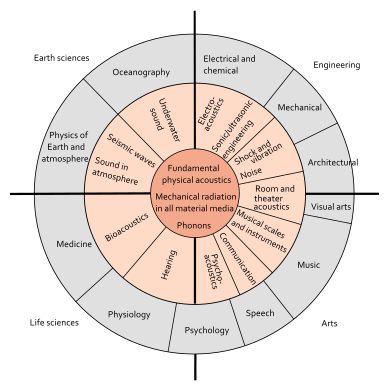Acoustics studies mechanical waves in matter through physics principles. Here’s a comprehensive overview of this fascinating field:
Acoustics Fundamentals
Acoustics represents the scientific study of mechanical waves in gases, liquids, and solids. An acoustician conducts research while an acoustical engineer applies the principles to technology. The field encompasses vibration, sound, ultrasound and infrasound.
Wave Properties Transform Sound
Sound waves propagate through media as pressure disturbances. In fluids like air and water, these waves create compressions and rarefactions. The human ear detects these tiny pressure variations – the smallest audible sound is nine orders of magnitude smaller than ambient pressure.
Frequency Defines Perception
The audio spectrum divides into three key ranges:
- Audio: 20 Hz to 20,000 Hz (human hearing range)
- Ultrasonic: Above 20,000 Hz
- Infrasonic: Below 20 Hz
Historical Development
Ancient Origins Shape Understanding
Pythagoras discovered mathematical relationships in musical harmony in the 6th century BC. He found that string length ratios using small integers produced pleasing sounds. Aristotle later described sound as air compressions, laying groundwork for wave theory.
Modern Advances Drive Innovation
The 18th century brought mathematical frameworks from Euler, Lagrange, and d’Alembert. The wave equation emerged to explain sound propagation. Helmholtz and Lord Rayleigh made major 19th century contributions to acoustics theory.
Applications Transform Society
Architecture Shapes Sound
Architectural acoustics optimizes sound in buildings through:
- Room acoustics design
- Speech intelligibility improvement
- Vibration reduction
- Noise control systems
Medicine Utilizes Waves
Medical applications include:
- Ultrasonography imaging
- Hearing aid development
- Speech therapy
- Acoustic neurology research
Music Creates Experience
Musical acoustics studies:
- Instrument physics
- Electronic music processing
- Music perception
- Cognitive neuroscience of music
The field continues evolving with new technologies while maintaining its foundation in classical physics principles.
Acoustics is a branch of physics that deals with the study of mechanical waves in gases, liquids, and solids including topics such as vibration, sound, ultrasound and infrasound. A scientist who works in the field of acoustics is an acoustician while someone working in the field of acoustics technology may be called an acoustical engineer. The application of acoustics is present in almost all aspects of modern society with the most obvious being the audio and noise control industries.

Hearing is one of the most crucial means of survival in the animal world and speech is one of the most distinctive characteristics of human development and culture. Accordingly, the science of acoustics spreads across many facets of human society—music, medicine, architecture, industrial production, warfare and more. Likewise, animal species such as songbirds and frogs use sound and hearing as a key element of mating rituals or for marking territories. Art, craft, science and technology have provoked one another to advance the whole, as in many other fields of knowledge. Robert Bruce Lindsay's "Wheel of Acoustics" is a well accepted overview of the various fields in acoustics.

